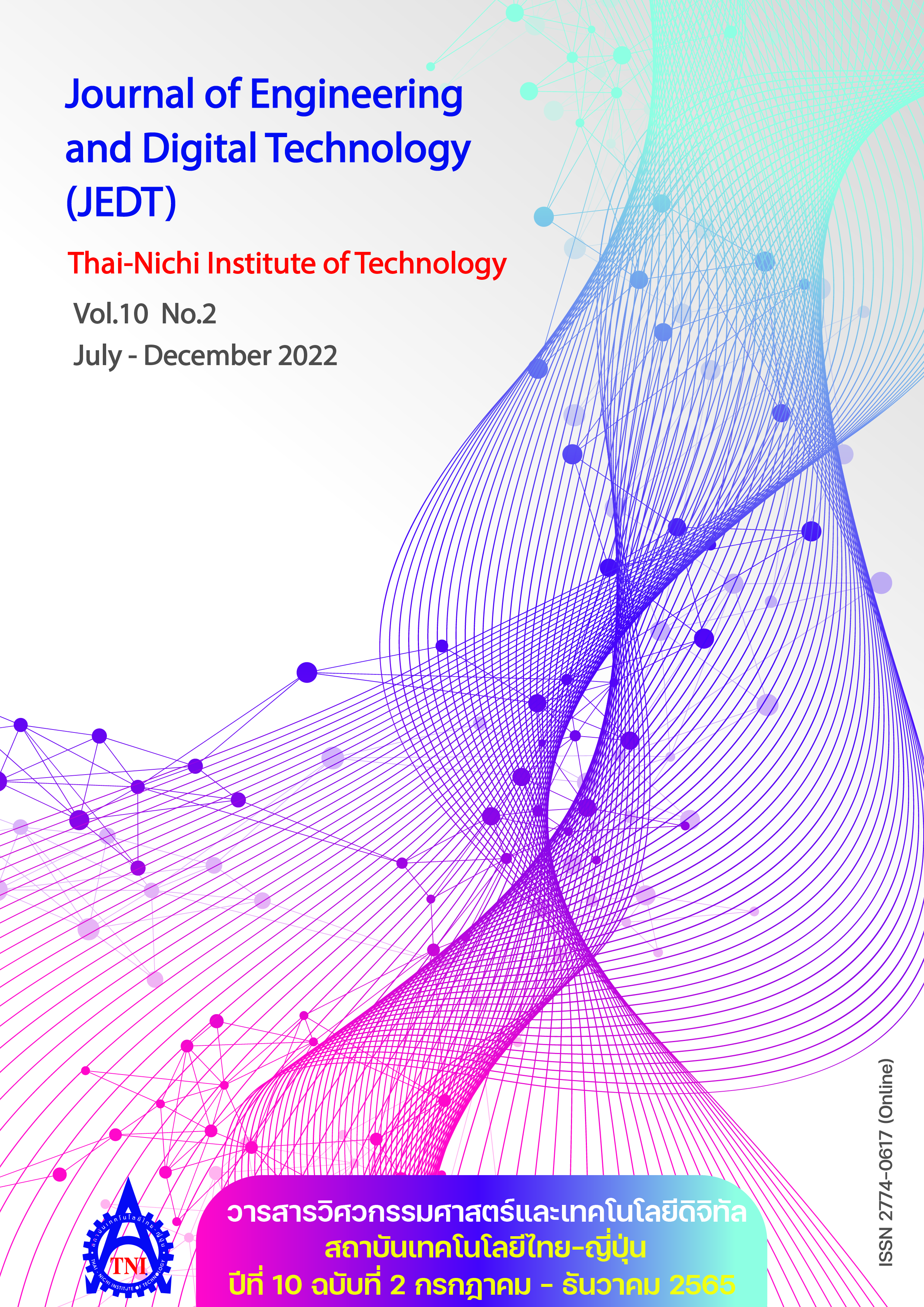การผลิตถ่านกัมมันต์จากกาบมะพร้าวที่อุณหภูมิต่ำภายใต้ภาวะจำกัดอากาศสำหรับการดูดซับเมธิลีนบลู
Main Article Content
บทคัดย่อ
การใช้ชีวมวลเหลือทิ้งทางการเกษตรที่เป็นวัตถุดิบในการผลิตถ่านกัมมันต์มีมากขึ้น เนื่องจากมีราคาถูกและมีปริมาณมาก ถ่านกัมมันต์ที่ผลิตได้สามารถใช้ในการกำจัดมลพิษในน้ำได้ งานวิจัยนี้จึงมีวัตถุประสงค์เพื่อศึกษาผลของอุณหภูมิและเวลาต่อการผลิตถ่านกัมมันต์จากกาบมะพร้าวจากพื้นที่ในจังหวัดชลบุรี โดยแบ่งการผลิตออกเป็น 2 ขั้นตอน คือ การผลิตถ่านชีวภาพและการผลิตถ่านกัมมันต์ จากการทดลองพบว่าอุณหภูมิและเวลามีผลต่อร้อยละผลได้ของแข็งและพื้นที่ผิวของถ่านชีวภาพอย่างมีนัยสำคัญ จากนั้นนำถ่านชีวภาพที่ผลิตจากภาวะต่าง ๆ มากระตุ้นด้วยโพแทสเซียมไฮดรอกไซด์ กรดฟอสฟอริก และกรดซัลฟูริก ความเข้มข้น 4 โมลาร์ และเผาที่อุณหภูมิและเวลาที่กำหนดเพื่อผลิตเป็นถ่านกัมมันต์ พบว่าชีวภาพที่ผลิตด้วยการเผาที่ 500 องศาเซลเซียส เป็นเวลา 1 ชั่วโมง จากนั้นกระตุ้นด้วยโพแทสเซียมไฮดรอกไซด์ที่อุณหภูมิ 200 องศาเซลเซียส เป็นเวลา 2 ชั่วโมง ได้ถ่านกัมมันต์ที่มีพื้นที่ผิวสูงสุด 1,147.74 ตารางเมตรต่อกรัม และการดูดซับเมทิลีนบลูสอดคล้องกับไอโซเทอร์มการดูดซับแบบแลงเมียร์ โดยมีค่า R2 เท่ากับ 0.9993
ผลการทดลองแสดงให้เห็นว่าการผลิตถ่านกัมมันต์จากกาบมะพร้าวสามารถดำเนินการที่อุณหภูมิต่ำได้ รวมถึงมีความเป็นไปได้ในการสร้างเตาเผาเพื่อผลิตถ่านชีวภาพและถ่านกัมมันต์ที่ไม่ซับซ้อนและต้นทุนไม่สูง สามารถลดการใช้พลังงานได้ และใช้ต้นทุนน้อยกว่าถ่านกัมมันต์ที่มีขายเชิงพาณิชย์ จึงแสดงให้เห็นถึงความเป็นไปได้ในการลงทุนหรือต่อยอดเป็นผลิตภัณฑ์สำหรับการดูดซับมลพิษต่อไป
Article Details

อนุญาตภายใต้เงื่อนไข Creative Commons Attribution-NonCommercial-NoDerivatives 4.0 International License.
นโยบายการรับบทความ
กองบรรณาธิการวารสารสถาบันเทคโนโลยีไทย-ญี่ปุ่น มีความยินดีรับบทความจากอาจารย์ประจำ และผู้ทรงคุณวุฒิในสาขาวิศวกรรมศาสตร์และเทคโนโลยี ที่เขียนเป็นภาษาไทยหรือภาษาอังกฤษ ซึ่งผลงานวิชาการที่ส่งมาขอตีพิมพ์ต้องไม่เคยเผยแพร่ในสิ่งพิมพ์อื่นใดมาก่อน และต้องไม่อยู่ในระหว่างการพิจารณาของวารสารอื่นที่นำส่ง ดังนั้นผู้สนใจที่จะร่วมเผยแพร่ผลงานและความรู้ที่ศึกษามาสามารถนำส่งบทความได้ที่กองบรรณาธิการเพื่อเสนอต่อคณะกรรมการกลั่นกรองบทความพิจารณาจัดพิมพ์ในวารสารต่อไป ทั้งนี้บทความที่สามารถเผยแพร่ได้ประกอบด้วยบทความวิจัย ผู้สนใจสามารถศึกษาและจัดเตรียมบทความจากคำแนะนำสำหรับผู้เขียนบทความ
การละเมิดลิขสิทธิ์ถือเป็นความรับผิดชอบของผู้ส่งบทความโดยตรง บทความที่ได้รับการตีพิมพ์ต้องผ่านการพิจารณากลั่นกรองคุณภาพจากผู้ทรงคุณวุฒิและได้รับความเห็นชอบจากกองบรรณาธิการ
ข้อความที่ปรากฏภายในบทความของแต่ละบทความที่ตีพิมพ์ในวารสารวิชาการเล่มนี้ เป็น ความคิดเห็นส่วนตัวของผู้เขียนแต่ละท่าน ไม่เกี่ยวข้องกับสถาบันเทคโนโลยีไทย-ญี่ปุ่น และคณาจารย์ท่านอื่น ๆ ในสถาบัน แต่อย่างใด ความรับผิดชอบด้านเนื้อหาและการตรวจร่างบทความแต่ละบทความเป็นของผู้เขียนแต่ละท่าน หากมีความผิดพลาดใด ๆ ผู้เขียนแต่ละท่านจะต้องรับผิดชอบบทความของตนเองแต่ผู้เดียว
กองบรรณาธิการขอสงวนสิทธิ์มิให้นำเนื้อหา ทัศนะ หรือข้อคิดเห็นใด ๆ ของบทความในวารสารสถาบันเทคโนโลยีไทย-ญี่ปุ่น ไปเผยแพร่ก่อนได้รับอนุญาตจากผู้นิพนธ์ อย่างเป็นลายลักษณ์อักษร ผลงานที่ได้รับการตีพิมพ์ถือเป็นลิขสิทธิ์ของวารสารสถาบันเทคโนโลยีไทย-ญี่ปุ่น
ผู้ประสงค์จะส่งบทความเพื่อตีพิมพ์ในวารสารวิชาการ สถาบันเทคโนโลยีไทย-ญี่ปุ่น สามารถส่ง Online ที่ https://www.tci-thaijo.org/index.php/TNIJournal/ โปรดสมัครสมาชิก (Register) โดยกรอกรายละเอียดให้ครบถ้วนหากต้องการสอบถามข้อมูลเพิ่มเติมที่
- กองบรรณาธิการ วารสารสถาบันเทคโนโลยีไทย-ญี่ปุ่น
- ฝ่ายวิจัยและนวัตกรรม สถาบันเทคโนโลยีไทย-ญี่ปุ่น
เลขที่ 1771/1 สถาบันเทคโนโลยีไทย-ญี่ปุ่น ซอยพัฒนาการ 37-39 ถนนพัฒนาการ แขวงสวนหลวง เขตสวนหลวง กรุงเทพมหานคร 10250 ติดต่อกับคุณพิมพ์รต พิพัฒนกุล (02) 763-2752 , คุณจุฑามาศ ประสพสันติ์ (02) 763-2600 Ext. 2402 Fax. (02) 763-2754 หรือ E-mail: JEDT@tni.ac.th
เอกสารอ้างอิง
Office of Agricultural Economics. “Mature coconut: Percentage and monthly yield including country, region and province in 2020.” OAE.go.th. https://www.oae.go.th/assets/portals/1/fileups/prcaidata/files/Coconut%20percent%2063.pdf (accessed Aug. 23, 2020)
S. Tatayanon, T. Piriyayotha, T. Boonyaem, and C. Osot, “Feasibility study on the simple production of activated carbon from biomass,” Forest Research and Development Bureau, Bangkok, Thailand, 2017. [Online]. Available: https://shorturl.asia/b3Jd0
Medthai. “Activated charcoal.” (in Thai), MEDTHAI.com. https://shorturl.asia/VWlpM (accessed Aug. 23, 2020)
J. Manaonok, S. Gonkhamdee, K. Dejbhimon, W. K. Polpinit, and D. Jothityangkoon, “Biochar: Its effect on soil properties and growth of wet-direct seeded rice (a pot trial),” (in Thai), Khon Kaen Agr. J., vol. 45, no. 2, pp. 209–220, 2017.
X. Tan et al., “Biochar as potential sustainable precursors for activated carbon production: Multiple applications in environmental protection and energy storage,” Bioresour. Technol., vol. 227, pp. 359–372, Mar. 2017.
M. Dwiyaniti et al., “Extremely high surface area of activated carbon originated from sugarcane bagasse,” in IOP Conf. Ser.: Mater. Sci. Eng., vol. 909, no. 1, 2020, pp. 1–8.
M. S. Reza et al., “Preparation of activated carbon from biomass and its’ applications in water and gas purification, a review,” Arab J. Basic Appl. Sci., vol. 27, no. 1, pp. 208–238, 2020.
Chulalongkorn University. “High quality smokeless charcoal briquettes and activated carbon products from agricultural waste by the learning and demonstration of solid fuel production center, Chulalongkorn University.” (in Thai), CHULA.ac.th. https://www.chula.ac.th/news/30933/ (accessed Aug. 23, 2020)
M. F. Nazzal, S. T. Ali, and I. A. Abdulwahab, “Removal of methylene blue dye from wastewater using activated carbon: A review,” Solid State Technol., vol. 63, no. 3, pp. 4290–4296, 2020.
S. Karagoz, T. Tay, S. Ucar, and M. Erdem, “Activated carbons from waste biomass by sulfuric acid activation and their use on methylene blue adsorption,” Bioresour. Technol., vol. 99, no. 14, pp. 6214–6222, Sep. 2008.
A. L. Ahmad, M. M. Loh, and J. A. Aziz, “Preparation and characterization of activated carbon from oil palm wood and its evaluation on Methylene blue adsorption,” Dyes and Pigments, vol. 75, no. 2, pp. 263–272, 2007.
J. Sabseree, “DOE: Central composite design,” For Quality, (in Thai), no. 145, pp. 72–74, Nov. 2009.
Z. Guo et al., “Activated carbons with well-developed microporosity prepared from Phragmites australis by potassium silicate activation,” J. Taiwan Inst. Chem. Eng., vol. 45, no. 5, pp. 2801–2804, Sep. 2014.
N. M. A. Lagtah, A. H. Al-Muhtaseb, M. N. M. Ahmad, and Y. Salameh, “Chemical and physical characteristics of optimal synthesised activated carbons from grass-derived sulfonated lignin versus commercial activated carbons,” Microporous Mesoporous Mater., vol. 225, pp. 504–514, May 2016.
C. R. Correa, T. Otto, and A. Kruse, “Influence of the biomass components on the pore formation of activated carbon,” Biomass and Bioenergy, vol. 97, pp. 53–64, Feb. 2017.
S. Li, K. Han, J. Li, M. Li, and C. Lu, “Preparation and characterization of super activated carbon produced from gulfweed by KOH activation,” Microporous Mesoporous Mater., vol. 243, pp. 291–300, May 2017.
Standard Test Method for Moisture Analysis of Particulate Wood Fuels, ASTM E871-82(2006), Nov. 26, 2013. [Online], Available: https://www.astm.org/e0871-82r06.html
Standard Test Method for Ash in Biomass, ASTM E1755-01(2015), Aug. 13, 2020. [Online], Available: https://www.astm.org/e1755-01r15.html
Standard Test Methods for Loss-On-Drying by Thermogravimetry, ASTM E1868-10(2021), Aug. 23, 2022. [Online]. Available: https://www.astm.org/e1868-10r21.html
N. Hegyesiab, R. T. Vadab, and B. Pukánszky, “Determination of the specific surface area of layered silicates by methylene blue adsorption: The role of structure, pH and layer charge,” Appl. Clay Sci., vol. 146, pp. 50–55, Sep. 2017.
A. Albalasmeh et al., “Characterization and artificial neural networks modelling of methylene blue adsorption of biochar derived from agricultural residues: Effect of biomass type, pyrolysis temperature, particle size,” J. Saudi Chem. Soc., vol. 24, no. 11, pp. 811–823, Nov. 2020.
A. Tomczyk, Z. Sokołowska, and P. Boguta, “Biochar physicochemical properties: pyrolysis temperature and feedstock kind effects,” Rev. Environ. Sci. Biotechnol., vol. 19, pp.191–215, 2020.
S. Pap et al., “Optimising production of a biochar made from conifer brash and investigation of its potential for phosphate and ammonia removal,” Ind. Crops. Prod., vol. 185, Oct. 2022.
M. Hu et al., “Towards understanding the chemical reactions between KOH and oxygen-containing groups during KOH-catalyzed pyrolysis of biomass,” Energy, vol. 245, Apr. 2022, Art no. 123286.
W. Chen et al., “Insight into KOH activation mechanism during biomass pyrolysis: Chemical reactions between O-containing groups and KOH,” Appl. Energy, vol. 278, Nov. 2020, Art. no. 1157303.
J. O. Amode, J. H. Santos, Z. Md. Alam, A. H. Mirza, and C. C. Mei, “Adsorption of methylene blue from aqueous solution using untreated and treated (Metroxylon spp.) waste adsorbent: equilibrium and kinetics studies,” Int. J. Ind. Chem., vol. 7, pp. 333–345, 2016.
L. Zhao et al., “Roles of phosphoric acid in biochar formation: Synchronously improving carbon retention and sorption capacity,” J. Environ. Qual., vol. 46, no. 2, pp. 393–401, 2017.
Y. Li, X. Zhang, R. Yang, G. Li, and C. Hu, “The role of H3PO4 in the preparation of activated carbon from NaOH-treated rice husk residue,” RSC Adv., vol. 5, no. 41, pp. 32626–32636, 2015.
N. Yuan, H. Cai, T. Liu, Q. Huang, and X. Zhang, “Adsorptive removal of methylene blue from aqueous solution using coal fly ash-derived mesoporous silica material,” Adsorpt. Sci. Technol., vol. 37, no. 3-4, pp. 333–348, 2019.


